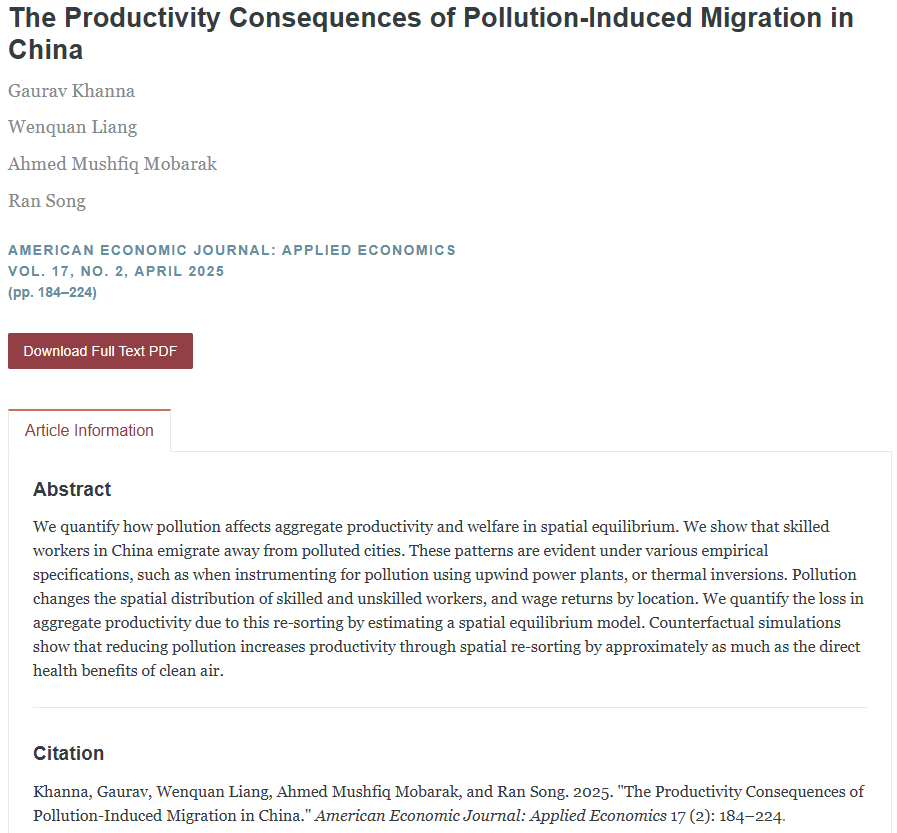
Associate Professor LIANG Wenquan of Tongji SEM Published Research in American Economic Journal: Applied Economics
Thu, May 22, 2025
Environmental pollution and population mobility are two important factors that affect economic growth in China. Through what mechanism does environmental pollution change the spatial mobility of the population, which in turn has an impact on economic development? To address this issue, LIANG Wenquan, Associate Professor of the Department of Public Administration, and Ahmed Mushfiq Mobarak, Professor of Yale University, Gaurav Khanna, Associate Professor of the University of California, San Diego, and Ran Song, Assistant Professor of the National University of Singapore have conducted a research and published a joint paper “The Productivity Consequences of Population Mobility” in the prestigious international journal “American Economic Journal: Applied Economics”.
Why do productivity gaps persist between regions and why does labor not move to mitigate these gaps? Taking an environmental pollution and household registration system perspective, this study uses data from China to address this classic economic question. The paper empirically demonstrates and quantifies the effect of pollution on overall productivity and welfare in spatial equilibrium, emphasizing the role of the household registration system.
The empirical findings suggest that China’s highly skilled labor force is migrating away from heavily polluted cities. This phenomenon is significant under different empirical model settings, such as when upwind power plants or inverse temperature phenomena are used as instrumental variables for pollution and geographic breakpoints, or when individual panel data is utilized. Pollution alters the spatial distribution pattern of high-skilled versus low-skilled labor, reshaping the level of wage returns across regions.
This study estimates the loss in overall productivity due to labor reallocation by constructing a spatial equilibrium model. Counterfactual simulations demonstrate that reducing pollution levels can contribute to productivity gains by optimizing the spatial allocation of labor, to a degree comparable to the direct health benefits of cleaner air.
Restrictions on labor’s spatial mobility imposed by a household registration system biased towards high skills can further worsen the impact of environmental pollution on overall productivity. This study provides a spatial equilibrium perspective on the discussion of environmental pollution control and household registration system reform in China.
For a geographically vast country such as China, viewing the Chinese economy from a spatial equilibrium perspective is a natural necessity. This paper examines the impact of environmental pollution from this perspective, with the findings highlighting China’s comparative advantage as a large country. It argues that spatial labor mobility amplifies the economic impact of pollution, implying that pollution control can achieve more substantial reform dividends through spatial adjustment. Future research could examine other important topics relating to the Chinese economy from a spatial equilibrium perspective.
We protect your privacy. We use cookies to personalize content, provide features, and analyze traffic to our website anonymously and in a privacy compliant manner. By law, we may store cookies on your device if they are strictly necessary for the operation of this site. For all other cookie types, we need your permission. For more information, please see the privacy policy linked below.